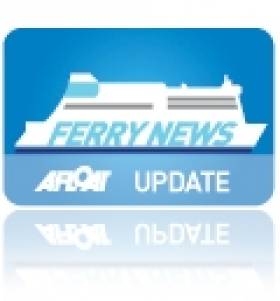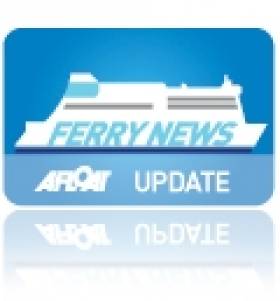Displaying items by tag: ICG Kaitaki charter
ICG Chartered Ferry Faces Delayed Refit Return to 'Interislander'
#Interislander – Irish Continental Group's Kaitaki which is on charter to New Zealand operator Interislander service is expected to be at least two weeks late.
The delay in re-entering of Kaitaki on the Cook Strait route follows unforeseen problems with a paint job during the ship's refurbishment in Brisbane.
As previously reported on Afloat.ie the Kaitaki left Wellington for Brisbane dry docking late last month for a repaint, revamp of the food court area, the bar, the atrium and the toilets, along with the passenger thoroughfare and shop on deck eight.
It was originally scheduled to re-enter service on the Cook Strait run from next Monday, September 2. For more on this story the Dominion Post has a report.
‘Irish’ New Zealand Flagship Ferry to Get a Facelift
#FerryFacelift – Following last month's decision by New Zeland ferry operator Interislander to renew the charter of Kaitaki from ICG for another four years to 2017, as previously reported on Afloat.ie, the ro-pax 22,365 tonnes flagship is to receive a refurbishment.
Passenger areas will be refurbished when the flagship goes to dry-dock in the Autumn, following her season running on the 92km route across the Cook Strait between Wellington and Picton, which has been described as "one of the most beautiful ferry rides in the world".
"Kaitaki passenger spaces have had no refurbishment in the last eight years of the current charter, so the passenger spaces are definitely in need of a facelift," says Interislander General Manager Thomas Davis.
Kaitaki, which means 'Challenger' in Maori, is just shy of 182 metres in length (the equivalent to almost two rugby fields), and can carry 1650 passengers and 550 cars.
"Kaitaki has been Interislander's flagship since her arrival in 2005 and is the largest passenger ferry in New Zealand. She has served us very well over the last eight years," Mr Davis says.
Originally the vessel was launched as Isle of Inishfree for Irish Continental Group (ICG) ferry subsidiary Irish Ferries, firstly to serve on the Dublin-Holyhead and later running Rosslare – Pembroke Dock.
The main scope of the work will include a revamp of the foodcourt area, the bar, the atrium and the toilets, as well as the passenger thoroughfare and shop on deck 8.
Approximately $4.5 million has been budgeted for this work for MJM Marine Ltd. The firm based in Newry, Co. Down has had significant experience in ferry and cruise ship refurbishment work, will be leading the project, in partnership with Swedish company Figura who specialise in ferry passenger design.
MJM Marine Limited has undertaken refurbishment work on cruise ships like Pacific Pearl, Saga Pearl and Celebrity Infinity, as well as Ro-Pax ferries like Stena Superfast.
"Over the last couple of years, Kaitaki has been the busiest she has ever been during the peak summer period. Interislander is really looking forward to being able to offer Kaitaki passengers a much fresher, more comfortable and modern travel experience following the completion of the refurbishment project in September," Mr Davis says.
For artists impressions of the refurbishment concepts, visit the ferry's facebook page.
#FerryCharter- New Zealand ferry operator Interislander has announced the renewal of the charter lease of Irish Continental Group's (ICG) ferry Kaitaki for another four years, writes Jehan Ashmore.
ICG which are the parent company of Irish Ferries, have chartered out the Kaitaki, (the former Irish Sea ferry Isle of Innisfree) to Interislander since 2005 and where the 22,365 tonnes ro-pax operates on the scenic north-south islands route between Wellington and Picton.
The voyage along the 92km distance long route takes 3 hours to complete across the Cook Strait and has been described as "one of the most beautiful ferry rides in the world".
The agreement by ICG to extend the bare boat charter of Kaitaki, to KiwiRail Limited trading as Interislander is a direct continuation from the current charter, which was due to expire on 30 June 2013 and where over the next four years, the annual charter rate is €3.75m.
Kaitaki which is the Maori translation for Challenger, is the flagship of the Interislander fleet and is the largest passenger ferry (with a 1,650 capacity) operating in New Zealand waters.
She has proved to be a valuable member of the fleet where freight levels have reached of up to 60 trucks transported on nightly sailings and to a lesser extent during day-time sailings. In addition the route provides time sensitive perishable goods deliveries between the islands.
Under the charter terms the agreement also provides for an option for Interislander to extend the charter beyond July 2017 for a further period of three years and at a reduced rate.
Originally the Dutch built ferry started a career as Isle of Innisfree, the first custom-built ferry for Irish Ferries, when introduced onto Dublin-Holyhead service in 1995.
Notably Isle of Innissfree's debut not only marked modernisation but investment confidence on the central corridor route which was part of B&I Line operations until ICG acquired the ailing state-owned company several years previously.
Further business accelerated on the Dublin route which led to a larger newbuild Isle of Inishmore enter service in 1997 and in which displaced the 'Innisfree' to Rosslare-Pembroke Dock route.
In turn 'Inishmore' was replaced and also transferred to the southern corridor route upon introduction of the giant new 'flagship' Ulysses in 2001.
With Isle of Innisfree having no role anymore on the Irish Sea in that year, she was laid up until 2002 when ICG chartered the ferry to P&O Ferries. As the renamed Pride of Cherbourg she ran from her namesake port to Portsmouth.
Following English Channel service the 550 car-capacity ferry then spent a stint in the Baltic Sea as Stena Challenger before heading for her current role in the southern hemisphere.































































